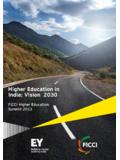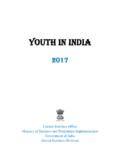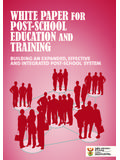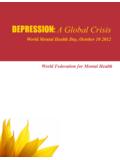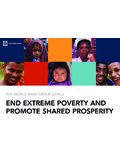Transcription of CHAPTER 2: ATTITUDES TOWARDS DISABILITY AND PEOPLE …
1 CHAPTER 2: ATTITUDES TOWARDS DISABILITY AND PEOPLE with disabilities This CHAPTER explores evidence on ATTITUDES to DISABILITY in india , and their implications for public policy. ATTITUDES of society, families and PWD themselves contribute to converting impairments into disabilities . Research in india has consistently found substantial social marginalization of PEOPLE with disabilities . The ATTITUDES of specific societies are critical in assessing both the intensity of DISABILITY ( how disabling a given type or level of impairment becomes for the individual disabled person) and in assessing areas where collective action is likely to fail the disabled community, and hence public action be desirable. In addition to the ATTITUDES of the general society, the ATTITUDES of persons with disabilities and their families are important, in some ways even more important.
2 At the same time, the different sets of ATTITUDES clearly interact, so that negative views about disabled PEOPLE in the broader community are likely to be internalized in many cases by PEOPLE with disabilities and their household members. Much of the literature on DISABILITY in india has pointed to the importance of the concept of karma in ATTITUDES to DISABILITY , with DISABILITY perceived either as punishment for misdeeds in the past lives of the PWD, or the wrongdoings of their parents. As two Indian authors have put it, At a profoundly serious and spiritual level, DISABILITY represents divine justice . 1 At a more mundane level, PEOPLE with disabilities are traditionally perceived as somehow inauspicious. Much qualitative research has found considerable social marginalization of PEOPLE with disabilities in india , though most also acknowledge that the social status of the PWD s family has an impact on their potential acceptance in society.
3 Box discusses images of PWD in Hindu mythology and Bollywood cinema by way of illustrating popular culture perceptions of PEOPLE with disabilities . Research from urban and rural Andhra Pradesh in the early 2000s asked PEOPLE about whether DISABILITY was a punishment or curse of The researchers found around 40 percent of respondents agreeing that it was, with the share of PEOPLE holding such views increasing with age, being higher among women, higher for lower socio-economic groups, and higher for those who were illiterate. Interestingly, there was not a major difference in such views between urban and rural respondents, though urban PEOPLE were slightly less likely to hold such views. This is in contrast to earlier qualitative research in Karnataka, which had found higher belief in medical causes of DISABILITY in urban The present study asked a similar question for a much larger sample of households in rural UP and TN, and the results are presented in Figure For both households with and without a disabled member, around half the respondents believed that DISABILITY was always or almost always a curse of God.
4 The variations in this belief between the two states were not dramatic. An additional interesting result was that in UP respondents in households with a PWD had a 15 percent higher share with this belief than households without a PWD member. 1 Bacquer and Sharma (1997); Coleridge (1993), Miles (1995), and Erb and Harriss-White (2002). 2 Rao et al (2003). Such insights are supported by qualitative work in rural AP by ActionAid (200*). 3 Lang (2000). Box : DISABILITY in Indian mythology and Bollywood movies An interesting perspective on Indian ATTITUDES to DISABILITY is two forms of mythology: the traditional Hindu myths which still play an important role in shaping social norms and values, and the modern myth machine of Bollywood, which has impacts on popular culture and society.
5 In Hindu mythology, the portrayal of PEOPLE with disabilities is overwhelmingly negative, but also exhibits a strong gender bias in terms of the perceived capacities of disabled men and women. Disabled men in the Hindu myths are in some cases powerful and capable PEOPLE . However, the visually impaired king Dritarashtra and the orthopedically impaired Shakuni side with the forces of evil in the Mahabharata war. Such images of powerful but evil and cruel disabled men have been reinforced by historical figures such as Taimur Lang. In contrast, women with disabilities in Hindu mythology are simply irrelevant. A prime example comes in a story from the Karthik Poornima, where Lord Vishnu refuses to marry the disfigured elder sister of Lakshmi, saying that there is no place for disabled PEOPLE in heaven.
6 The sister is instead married to a peepul tree. In Bollywood films in which PWD feature, several common images of disabled men and women emerge. Firstly, the disabilities of hero(ine)s are typically acquired after birth rather than congenital, normalizing the actor somewhat. Equally, the DISABILITY is quite often cured during the course of the film. In addition, the stars are often from better-off socio-economic strata, with resources to promote their integration, though they remain often dependent on others. Apart from these similarities, there are also gender differences in perceptions of disabled PEOPLE in Bollywood movies. First, men with disabilities feature far more often than women with disabilities . Second, men with disabilities are often loved by a devoted woman without disabilities (as in Saajan), whereas women with disabilities are rarely loved by men without disabilities (and in cases where they are such as Mann, the men loved them before the onset of DISABILITY ).
7 Third, women with disabilities almost never attain economic self-sufficiency. While male stars with disabilities may not be very wealthy, they can attain such independence. Finally, the disabilities that women are portrayed with are very rarely ones that impact their physical appearance, so that they largely remain beautiful. Overall, women with disabilities in india cinema are doubly weak women and women with disabilities . This contrasts to more frequent portrayals in Hollywood cinema of women with disabilities who have strength and discover independence. However, it is important also to note films that have sought to enhance the sensitivity of society TOWARDS the needs, rights, sensibilities and potential of PEOPLE with disabilities - Sparsh, Black, Koshish (both old and new), Jagriti, Dosti, Main Aisa hi hun and Koi Mil Gaya to name a few.
8 Lagaan is an excellent example of a mainstream film that has highlighted the process of inclusion of a dalit disabled person. In the absence of opportunities for interaction between PEOPLE with disabilities and society at large, such films have played an important role in highlighting aspects of the lives of PEOPLE with disabilities that are not clearly understood and in dispelling myths and biases that society holds about them. Films such as those noted have also demonstrated the attempt of non-disabled PEOPLE to understand PEOPLE with disabilities . At a different level, there are initial but interesting initiatives in the NGO sector on the issues of media and PEOPLE with disabilities . There have been already two national film festivals on DISABILITY issues, and a third focusing on mentally challenged PEOPLE was held in November 2006.
9 Related to this, NGOs have also tried more directly to stimulate film and media material by PWD themselves, and to engage the Indian film and television industry on DISABILITY issues. For example, Brotherhood, a Delhi-based NGO, has organized training workshops for PEOPLE with disabilities on film making, and conducted sensitization sessions with Indian scriptwriters and film-makers. As a result, short films by disabled PEOPLE have been made. Brotherhood is currently seeking financial support to establish a national DISABILITY film and communication centre which would conduct research on portrayal of disabled PEOPLE in film and media, develop an archive of films on DISABILITY issues, sensitize film makers, journalists and other media PEOPLE , and directly support film makers, in particular disabled film-makers, through availability of basic equipment and studio facilities.
10 Sources: Bhambani (2003) and (2005). Sharma (2006); Materials from Brotherhood. The results in Figure are aggregated across different DISABILITY types. The survey also asked the same question by major DISABILITY categories, and results are presented in Figure which show significant differences in the perception of DISABILITY as a curse according to type of DISABILITY , with both visual and mental disabilities viewed as more likely to be due to a curse of God, and non-polio locomotor DISABILITY (in most cases from injuries/accidents) significantly lower than average (though still substantial). Half rural respondents in rural UP and TN believe that DISABILITY is always a curse of God Figure : Belief that DISABILITY a curse of God, rural UP and TN, 2005 Figure 10203040506070 All PWDUP PW DTN P W DAll non-PWDUP non-PWDTN non-PWD% of respondents Source: UP and TN survey, 2005.










